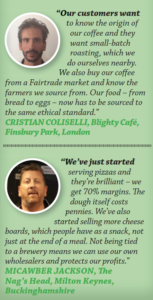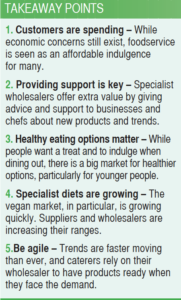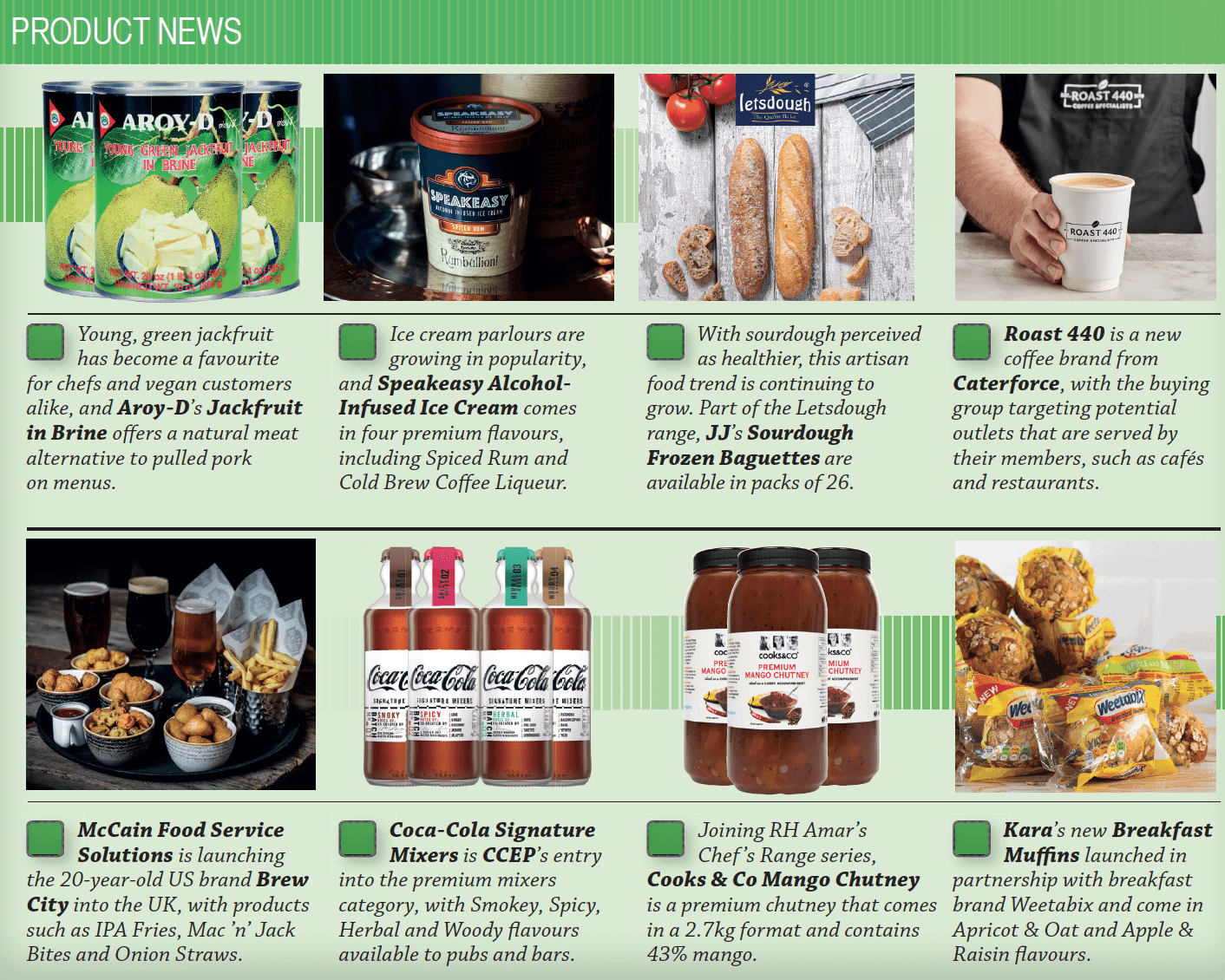Tom Gockelen-Kozlowski takes a dive into the huge foodservice sector and the opportunities and challenges it brings wholesalers
Economic uncertainty would suggest to the layman that diners would pull back their spending in foodservice, but suppliers are instead saying that the channel offers a means of affordable escapism.
Indeed, rather than the trends in foodservice driving a race to the bottom – which has too often been the case in retail – innovation is often encouraging more spending and better margins for operators and wholesalers.
“In the current economic climate, consumers are being extra cautious with their spending so when they do eat out, they’re really looking to indulge,” says Jane Woodhead, co-founder of Speakeasy Ice Cream.
 The company creates “luxury alcohol-infused ice cream” and Woodhead points to people’s increasingly busy lifestyles as another reason why luxury in foodservice is flourishing as a way for diners to treat themselves without breaking the bank.
The company creates “luxury alcohol-infused ice cream” and Woodhead points to people’s increasingly busy lifestyles as another reason why luxury in foodservice is flourishing as a way for diners to treat themselves without breaking the bank.
Premium
According to MCA Insight’s 2019/20 Food and Drink report, ice cream parlours are among the most-favoured eating-out spots this year.
Other premium trends are also driving activity in the market. JJ Foodservice, for example, is looking to capitalise on the booming artisan bread market with the launch of own-label multigrain and plain white sourdough loaves.
Part-baked frozen baguettes take advantage of a trend that’s forecast to “keeping growing globally by 6.9% through to 2023”, the firm says.
Burgers are another area where bread is all important, as the launch of the free-to-download Gourmet Burger Guide emphasises. Kate Sykes, marketing manager at Lantmännen Unibake, says: “With 84% of burger consumers seeing a quality bun as a key characteristic of a gourmet burger offering, trading up is essential.”
Flavours
Also vital to the trend for premium and luxury is the rise of stand-out flavours. “Everyone’s craving bold flavour experiences,” says McCormick’s executive chef, Kevan Vetter. The firm produces flavourings, spices and seasoning for the foodservice channel and manufacturers including Schwartz.
“Everyone’s craving bold flavour experiences,” says McCormick’s executive chef, Kevan Vetter. The firm produces flavourings, spices and seasoning for the foodservice channel and manufacturers including Schwartz.
It’s worth noting some of the (drinks-based) suggestions Vetter makes. He says: “A chilli-spiced watermelon rosé granita and a blueberry vanilla caamansi (Phillipine Lime) juice shaved ice are innovative ideas to meet growing online searches for online mocktails.”
These flavours are inspired both by the rise and broadening of diners’ appetites for international cuisine, plus the increase in food markets and street food that has now broken out of the big cities.
Caribbean cuisine is one clear beneficiary. “Jerk seasoning is now mainstream, and ingredients such as plantain, goat and hot pepper sauces are becoming much more familiar,” says Tom Styman-Heighton, development chef at Funnybones Foodservice.
As Caribbean cuisine – as well as Vietnamese, German and Ethiopian, to name but a few – makes a greater impact, specialist wholesalers such as Funnybones are ready to guide chefs where necessary.
“As specialist wholesalers, our role is to support our foodservice customers. We aim not only to supply chefs, but also to educate, guide and suggest new products, trends and tastes,” says Styman-Heighton.
It is not only specialist wholesalers that have noticed the opportunity. “In pub restaurants, core lines will always remain on the menu. However, with the increasing variety of foods on offer, the public is willing to try a greater range of world cuisine,” says Nick Ash, foodservice channel controller at RH Amar.
Dark kitchens
Another key trend connected to premium is convenience. The rise of apps such as Deliveroo and Uber Eats is transforming businesses from major chains to local cafés.
“The growth in popularity of Just Eat, Deliveroo and other phone-app delivery services is only going to continue,” says Ash. “As a society, we are constantly looking for products and services that make our lives easier,” he adds.
Some businesses are embracing this trend in surprising ways. As first reported in the Guardian, the rise of so-called ‘dark kitchens’ in major cities is seeing popular restaurants, from chains like Byron and Franco Manca to local favourites, opening second, delivery-only kitchens in units away from everyday diners.
But, according to caterers, there is another major trend linked to premium that is growing in importance: provenance.
This comes in two forms. The first is that staff – and therefore customers – are able to provide information on the source of products from the welfare of animals in the supply chain to the country, region and even farm from which a product originates.
David Robertson, whose family owns and runs a café and restaurant in Buckie, Banffshire, is proud that many of his ingredients are local.
But he also benefits from a second element of traceablity. “We have a local ice cream supplier who gives us information on where they source every ingredient for every flavour they have, which we have behind the counter so we can tell our customers,” he says.
His sandwiches are also freshly made to order – an element of his business made essential by the rise of Subway – which enables customers to pick exactly what is in their sandwich.
This has become more important following changes in regulations regarding allergens on food labelling, but also provides an element of choice customers are willing to pay extra for.
“I like olives, but some don’t, so this way people have a choice,” Robertson says.
This points to the final major trend changing foodservice. An olive aversion may be among the mildest dietary requirements, but from gluten-free to vegan, more customers expect whatever diet they are following to be catered to.
Challenges
“One of the biggest challenges facing our customers is preparing dishes that cater to all the specialist diets,” says Styman-Heighton.
 The company benefits from the fact it has long traded in jackfruit, an ingredient chefs and vegans alike rely on for what Styman-Heighton describes as its “satisfying, meaty texture”.
The company benefits from the fact it has long traded in jackfruit, an ingredient chefs and vegans alike rely on for what Styman-Heighton describes as its “satisfying, meaty texture”.
Specialist diets might be the wrong phrase, for while customers are willing to pay more for luxury and premium products, health is becoming ever-more important for those dining out – with vegetarian and vegan options perceived as a way of indulging in a healthier way.
“Three quarters of industry leaders expect healthy eating to grow fastest over the next three to five years,” according to McCormick’s Vetter.
Perhaps this is good news, because as new cuisines, delivery methods and dietary demands change the way your catering customers operate, they will find new ways to boost margins by being as creative and innovative as possible.
The question is, will you be the creative partner that they need?








